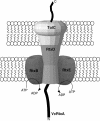Vibrio cholerae strains with mutations in an atypical type I secretion system accumulate RTX toxin intracellularly
- PMID: 15547287
- PMCID: PMC529086
- DOI: 10.1128/JB.186.23.8137-8143.2004
Vibrio cholerae strains with mutations in an atypical type I secretion system accumulate RTX toxin intracellularly
Abstract
This study shows that the Vibrio cholerae RTX toxin is secreted by a four-component type I secretion system (TISS) encoded by rtxB, rtxD, rtxE, and tolC. ATP-binding site mutations in both RtxB and RtxE blocked secretion, demonstrating that this atypical TISS requires two transport ATPases that may function as a heterodimer.
Figures






Similar articles
-
Growth phase regulation of Vibrio cholerae RTX toxin export.J Bacteriol. 2007 Mar;189(5):1827-35. doi: 10.1128/JB.01766-06. Epub 2006 Dec 22. J Bacteriol. 2007. PMID: 17189368 Free PMC article.
-
Vibrio cholerae tolC is required for bile resistance and colonization.Infect Immun. 2001 Jul;69(7):4681-5. doi: 10.1128/IAI.69.7.4681-4685.2001. Infect Immun. 2001. PMID: 11402016 Free PMC article.
-
Autoprocessing of the Vibrio cholerae RTX toxin by the cysteine protease domain.EMBO J. 2007 May 16;26(10):2552-61. doi: 10.1038/sj.emboj.7601700. Epub 2007 Apr 26. EMBO J. 2007. PMID: 17464284 Free PMC article.
-
[Toxins of Vibrio cholerae].Mol Gen Mikrobiol Virusol. 2005;(1):7-18. Mol Gen Mikrobiol Virusol. 2005. PMID: 15790027 Review. Russian.
-
The Vibrio cholerae type VI secretion system: toxins, regulators and consequences.Environ Microbiol. 2020 Oct;22(10):4112-4122. doi: 10.1111/1462-2920.14976. Epub 2020 Mar 13. Environ Microbiol. 2020. PMID: 32133757 Review.
Cited by
-
Coordinated delivery and function of bacterial MARTX toxin effectors.Mol Microbiol. 2018 Jan;107(2):133-141. doi: 10.1111/mmi.13875. Epub 2017 Dec 5. Mol Microbiol. 2018. PMID: 29114985 Free PMC article. Review.
-
The Vibrio cholerae flagellar regulatory hierarchy controls expression of virulence factors.J Bacteriol. 2009 Nov;191(21):6555-70. doi: 10.1128/JB.00949-09. Epub 2009 Aug 28. J Bacteriol. 2009. PMID: 19717600 Free PMC article.
-
Molecular detection and phylogenetic analysis of Vibrio cholerae genotypes in Hillah, Iraq.New Microbes New Infect. 2020 Aug 7;37:100739. doi: 10.1016/j.nmni.2020.100739. eCollection 2020 Sep. New Microbes New Infect. 2020. PMID: 32874595 Free PMC article.
-
TolC affects virulence gene expression in Vibrio cholerae.J Bacteriol. 2011 Oct;193(20):5850-2. doi: 10.1128/JB.05222-11. Epub 2011 Aug 19. J Bacteriol. 2011. PMID: 21856848 Free PMC article.
-
MARTX, multifunctional autoprocessing repeats-in-toxin toxins.Infect Immun. 2007 Nov;75(11):5079-84. doi: 10.1128/IAI.00525-07. Epub 2007 Jul 23. Infect Immun. 2007. PMID: 17646359 Free PMC article. Review. No abstract available.
References
-
- Alberts, P., O. Daumke, E. V. Deverson, J. C. Howard, and M. R. Knittler. 2001. Distinct functional properties of the TAP subunits coordinate the nucleotide-dependent transport cycle. Curr. Biol. 11:242-251. - PubMed
-
- Alm, R. A., and P. A. Manning. 1990. Characterization of the hlyB gene and its role in the production of the El Tor haemolysin of Vibrio cholerae O1. Mol. Microbiol. 4:413-425. - PubMed
-
- Bouabe, H., and M. R. Knittler. 2003. The distinct nucleotide binding states of the transporter associated with antigen processing (TAP) are regulated by the nonhomologous C-terminal tails of TAP1 and TAP2. Eur. J. Biochem. 270:4531-4546. - PubMed
Publication types
MeSH terms
Substances
Grants and funding
LinkOut - more resources
Full Text Sources
Other Literature Sources
Molecular Biology Databases

